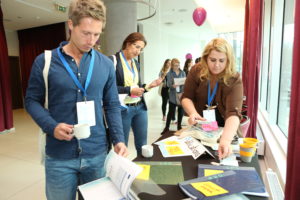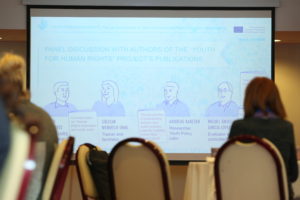Mapping and HRE resources
In the framework of the ‘Youth for Human Rights’ project, we kicked off by putting together national reports on human rights education (HRE) in the field of youth. All the partners conducted basic desk research and interviews to study the overall state of play when it comes to implementation of HRE in the field of youth.
National mappings and their synthesis report
From the national mappings, a common mapping synthesis report was put together. You can read the report there: mapping synthesis report. All the original national reports can be found in the Annex of the synthesis report. The synthesis report has been distributed by this project’s Training of Trainers (ToT) participants in order to build their national trainings, based on the input gathered.
| First Steps | Compass | Compasito | Bookmarks | Mirrors | Gender Matters | T-Kit 12: Youth transforming conflict | Tool Kit access to rights | No barriers, no borders | All human beings… | “Can ya Makan… Human Rights” |
Please evaluate and rate the above listed HRE resources and materials HERE in a public Padlet so we can understand better to what extend these match your current needs and work demands in the field of youth! The Padlet is open till the end of December 2019 for everyone to use.
 Transnational mapping
Transnational mapping
Apart from this, there is also a transnational mapping report available which has been put together within the framework of this project, and carries these specific purposes:
• to identify the best practices of existing training concepts of (1) training of trainers (ToT), and (2) training of youth workers, as well as (3) educational resources on HRE on transnational level;
• to identify the further needs and what is missing (e.g. resources or training needs of key actors) from the ‘current menu’ of existing concepts, approaches, actors, and educational resources on HRE in the field of youth on transnational level, through mapping and focus groups of experts.
The best practice of the project, as identified in this report, was gathered on the basis of data and overview compiled in the following areas relating to HRE:
• Actors, concepts, educational resources, approaches and training needs in the field of training of trainers, training of youth workers and of youth work students as well as of Erasmus+ NA staff on HRE in the field of youth at European and national levels are achieved
• Concepts and curricula for training of trainers, of youth workers and of Erasmus+ NA’s staff on human rights education are developed and tested, further adapted and implemented; for this purpose expert analysis of and recommendations for the adaptation and/or development of training tools and materials on HRE suitable for the field of youth is provided
The reports were overseen by a group of Experts, please find the Call for Experts there. The Call for researcher is available there.
Concept paper
Based on the mappings, an independent academic paper was put together by our project Experts on human rights education and youth work in order to bridge the gap in between formal preparation of youth workers to HRE practice in non-formal education. Please read the HRE concept paper there. The Call for Formal Education paper authors is there.
Policy brief (lessons learnt)
Moreover, also based on mappings, a policy brief was put together in October 2018 to highlight the developments within the project, and was introduced in the Key Action 3 Consortium of projects meeting of the Erasmus+ National Agencies. Please find here synopsis on lessons learned (policy brief), and some outcomes of the discussions are to be found in Padlet.
Follow-up papers:
Discussion paper on Human Rights Education
Brief for discussion 2020: NA Priorities for 2020-21 and project results
RAY research factsheet and survey report / policy brief (evaluation of capacity building events)
A survey report / policy brief with key findings of the project capacity building events, such as training of trainers, national training of youth workers and staff training, was put together by RAY team. They also came up with a shorter research factsheet. Please find the Call for Ray Survey there.


